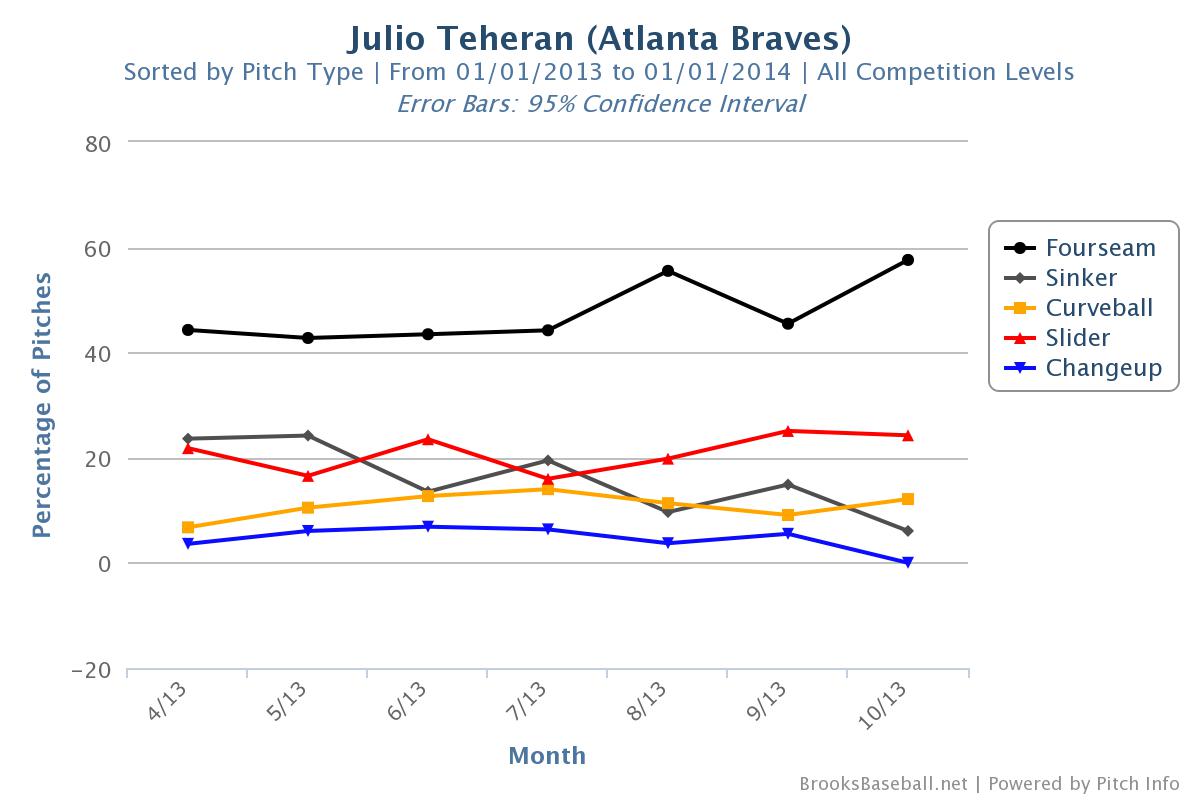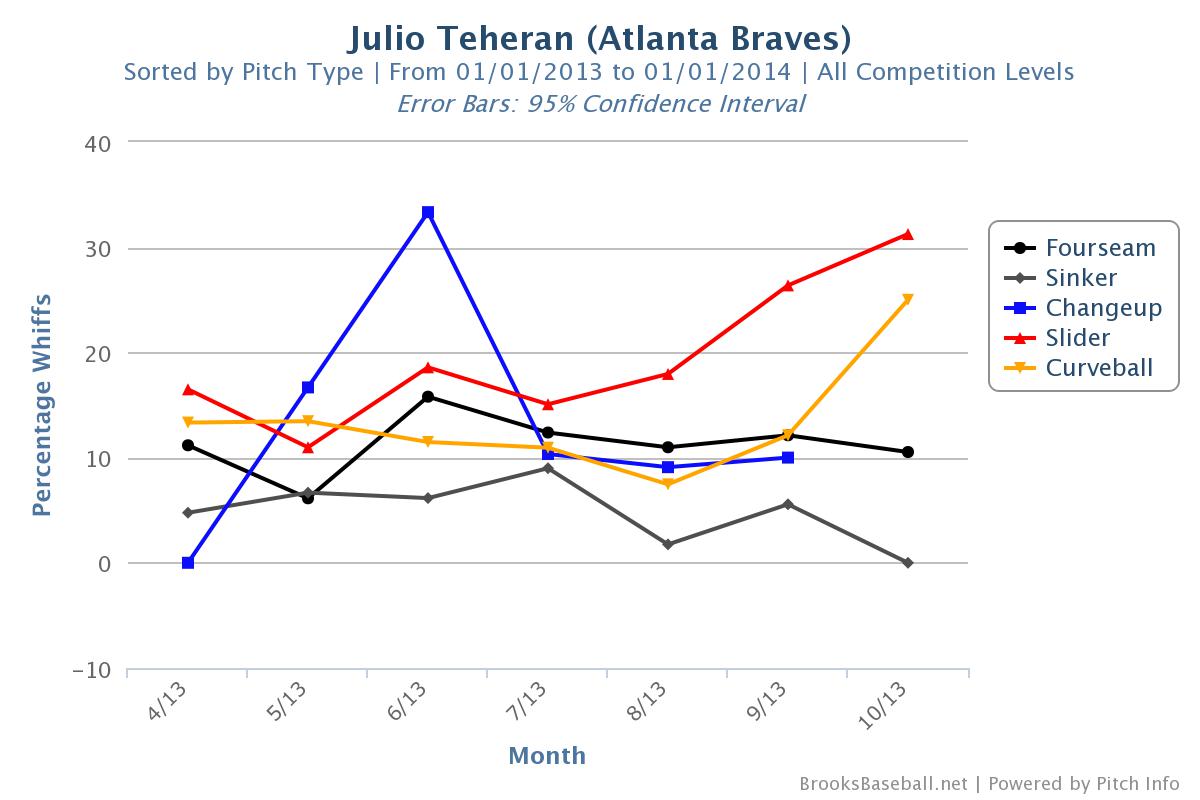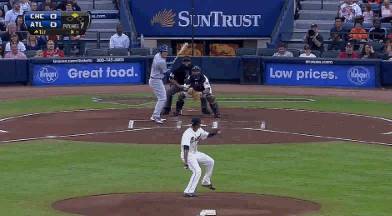2014 Fantasy Baseball: Julio Teheran and His Quest Upward

Over the next few weeks as the season – draft season, specifically – draws nearer I want to focus on players that I believe are either undervalued or overvalued in respect to their pre-draft site rankings. Julio Teheran, of the Atlanta Braves, is our first focus.
Not many players have the pedigree that Julio Teheran does. Teheran’s rankings as a prospect speak to the potential that he finally harnessed last season. Starting in 2010 and moving forward, Teheran received ranks from Baseball America of: 51, 5, 5, and finally 44 after his dismal Triple-A season in 2012. Despite his no good, terrible season at Triple-A in 2012, Teheran turned back the clock and put together a phenomenal season for Atlanta, in which he compiled 2.4 fWAR (3.6 RA-9 WAR) in 185.2 innings. His WAR – in both forms of evaluation – was good for third among rookies, trailing only Jose Fernandez and Hyun-Jin Ryu. In fantasy evaluations – which are more important to most of you – Teheran ranked 29th among starting pitchers according to ESPN and 22nd according to Fangraphs’ Zach Sanders. Not bad for a player who likely wasn’t even drafted in many casual leagues.
BE PREPARED FOR YOUR FANTASY DRAFT, GRAB OUR 2014 FANTASY BASEBALL DRAFT GUIDE!
Coming into 2014, I am a little higher on Teheran than many of my colleagues – ranking him 20th among starting pitchers. ESPN’s newly released rankings have him pegged at 31st among starters and 127th overall. Yahoo has him listed at 28th and 100th, respectively. For comparison’s sake, Teheran finished 2013 94th on ESPN’s player rater – 33 spots below his initial ranking. I believe there is a bargain to be had here.
Teheran’s dismal 2012 was mainly due to an attempt – apparently on the organization’s suggestion – to alter his mechanics. Talking Chop has a full rundown here, but here are the highlights:
Teheran has an electric arm, but his delivery had some violence that the Braves wanted to iron out in order to reduce his risk of injury. In 2012, they decided to reduce the bend on his back leg during his windup. He had been turning and coiling his body to generate more momentum toward the plate, placing additional strain on his right knee and elbow. Atlanta worked with Teheran on keeping his back leg straighter in order to create a better center of balance, particularly in his core.
In the Braves’ defense, the change was attempted in order to help limit some of the injury risk they believed Teheran may be opening himself up to. Unfortunately, his velocity suffered and he began serving up longballs at an alarming rate. Thankfully the Braves realized that their quest had erred and allowed Teheran to right the ship and return to his old delivery, noted here by Frank Wren during December of 2012 after a winter league appearance.
Wren said Teheran’s motion looked more fluid.
“We wanted him to get back to a more natural delivery where he’s not thinking about his mechanics, and I think he’s accomplished that,” Wren said. “His mechanics were very good. He looked much more natural and like he did two years ago.”
So, heading into 2013, Teheran had his motion back, but his doubters – myself, included – were fully intact. He proved all of us wrong. He looked phenomenal in Spring Training – not that it matters much, but it’s nice. But then fans were sent into a frenzy after he posted 7.31 ERA in his first three starts of the season. No worries though, because he reeled off a 2.81 ERA over his next 169.2 innings (27 starts) and established himself as one of the game’s premier talents.
Now that background information is out of the way, let’s get down to reason we’re here. Teheran was good the entire season, but in the second half, he really, really upped his game.

Teheran’s second half was phenomenal. His K%-BB% – information on why I prefer that to K/BB is here – was 16th best in the second half, among starters. The second half saw him walk more batters, but the ~3% jump in walks was offset beautifully by his ~6% jump in strikeouts. The source of Teheran’s strikeouts isn’t exactly a mystery. When Teheran was shooting up prospect lists his change-up was his most devastating secondary pitch – more on that in a moment – but his slider stole the show in 2013.

Teheran’s change-up was basically nonexistent all season. And his curveball began to be scrapped – except for October, which only saw a spike due to the small sample size of one playoff game – more and more as the season went on. His slider, which I had honestly heard nothing about before this season was Teheran’s go-to secondary offering.

Teheran’s slider saw not only increased usage, but increased whiffs throughout the year. The pitch – which was a definite work in progress at the start of the season – improved every month.


Those two gifs – one to each batters’ box – show you how the pitch behaves. These two gifs were taken from an August start versus the Marlins in which Teheran struck out eight batters over 6 1/3 innings. His decision to scrap the curveball and use the slider makes a lot of sense when you compare the pitch to this curveball from his first start of the season.

Yikes. The two pitches are obviously, very different. The two above sliders come into the zone around 84 mph and break down and horizontally much more sharply than the 77 mph get-me-over curve in the second gif. Not to mention, his delivery in the two earlier gifs looks much more in sync and free than it does in the latter.
The worrisome part about using a slider more? They have large platoon splits. Teheran is no different – or is he? Left handed batters hit .167 against his Teheran’s slider; but they slugged a whopping .583! Of the 14 home runs Teheran gave up in 2013 to LHB, 6 came off of his slider. It isn’t all bad though, because left handed batters whiffed on ~42% of their swings on the pitch. The message here – at least so far – is that lefties had trouble barreling his slider, but when they made contact, it was damn good contact.
Teheran also began utilizing his four seam fastball more throughout the season. The decision – once again – makes sense because his four seam fastball is thrown with much more velocity and misses more bats. Unfortunately for Julio, his sinker is his only pitch that gets ground balls at an acceptable rate.
Teheran is a fly ball pitcher, so scrapping the sinker, is somewhat alarming. Despite his penchant for allowing fly balls Teheran gave up home runs at a league average rate (10%) in 2013, according to HR/FB. His HR/FB rate in the second half was a little lower; sitting at ~8%, despite the fact that his FB rate increased, so that could/should regress back to around league average.
Pitching is give and take, and it’s pretty obvious that Teheran began going for strikeouts more than ground balls. The results were good, but I’d still like to see a few more ground balls, just to be on the safe side.
Making a Jump in 2014
Teheran’s main road to stardom is his change-up. His slider had fine results against left handed batters in 2013, but finding his change-up again gives him a better weapon to utilize. Teheran’s change-up was never the same once his mechanics were tinkered with. A new grip was attempted, but quickly scrapped.
As Teheran progressed through his first five starts of this season, he was reluctant to throw his changeup because of an inability to command the pitch on a consistent basis. But the off-speed pitch once again became a key part of the 22-year-old right-hander’s arsenal, as he limited the Giants to three runs in seven innings on Thursday night.
During Thursday’s win, Teheran threw 10 changeups, which were six fewer than the total he threw in his previous five starts. He credited his improved ability to command the pitch on the decision to go back to the grip he utilized during his early Minor League days, when his changeup helped establish him as one of the game’s top pitching prospects.
It’s difficult to find a pitch during the season. Teheran “found” his slider more and more throughout the year, but it’s much more difficult to develop the feel for a pitch as finicky as a change-up without constant repetition. And the major league schedule doesn’t quite offer the amount of time between starts to really revamp a pitch that someone has lost confidence in.
Teheran’s change-up was – on average – 11 mph slower than his fastball, in 2013. It’s a rather large gap , and a nice sign that the pitch could generate a fair amount of whiffs despite it’s middling movement, both horizontally and vertically, in comparison with other change-ups, and generate more ground balls. Finding his change-up – which was considered a plus offering by scouts for years – is Teheran’s best bet for getting more grounders and also adding a few more strikeouts to his already above average rate.
Even without a change-up, Teheran is still a very good starting pitcher. My ranking is based on the opinion that he’ll at least find some sort of a feel for the pitch and at least use it enough to keep opposing batters guessing. If he develops his feel for his change-up again, we’re looking at a top-10 major league pitcher who is on a good team and has already proven that he can handle a good sized workload at a young age.

The ZiPS projection system is a believer in Teheran moving into 2014; projecting him to suppress runs at 10% better than league average, while striking out a good amount of batters. The projection system – which uses minor league data in conjunction with major league data – also believes in Teheran’s command, which took a large step forward from his previous years’ under the tutelage of Roger McDowell in 2013. There’s a lot to like Teheran in 2014. I happen to like him more than most, maybe because he absolutely wowed me down the stretch. I am buying in wherever I’m able because, I believe the upside is simply to great to pass on at his current cost.





